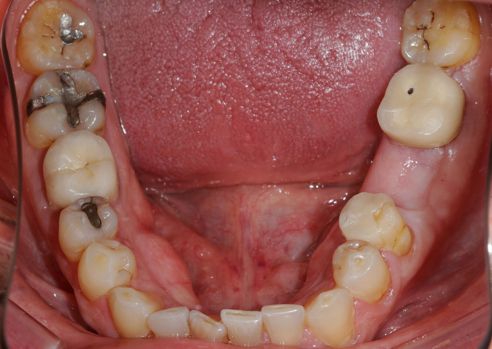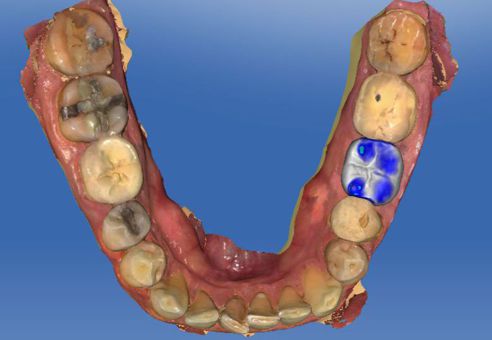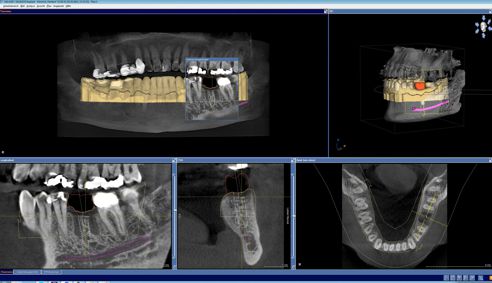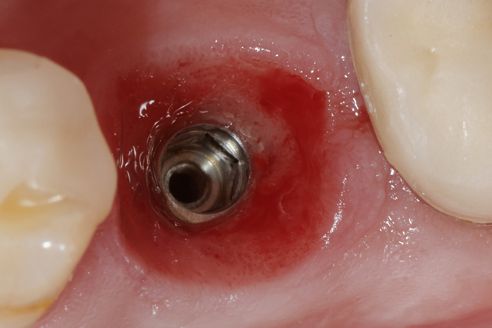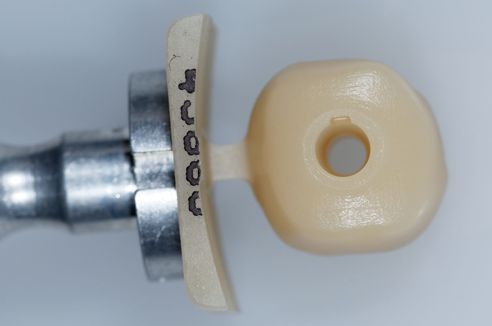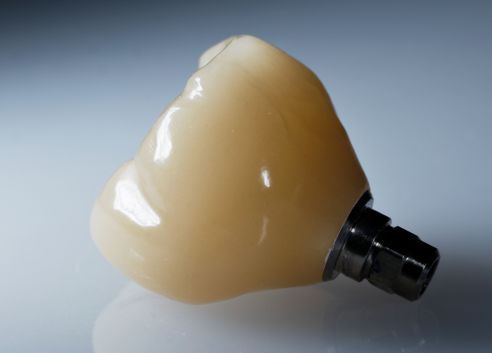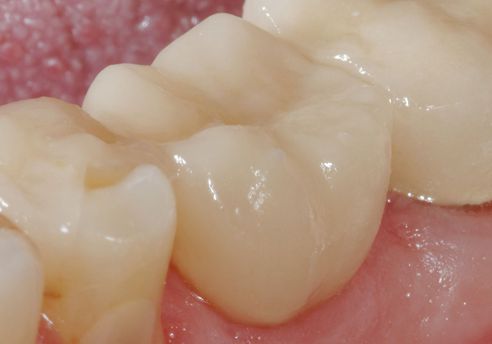VITA ENAMIC IS – excellent solution for one-part abutment crowns
80% of peri-implant complications in implant-supported restorations can be attributed to cementitis1. If the reconstruction is done using abutment crowns, the named complications can be largely avoided. Abutment crowns are one-part implant crowns which are screwed in directly and designed as fully anatomical. VITA Zahnfabrik offers VITA IMPLANT SOLUTIONS (IS) blanks (VITA Zahnfabrik, Bad Säckingen, Germany) for this type of restoration. The blanks have an integrated interface with an adhesive/titanium base (TiBase, Sirona Dental, Wals, Austria). The use of these CAD/CAM blanks is described in the following case report.
Initial situation, planning and implantation
After tooth loss in region 36, the male patient (born 1952) presented with the desire for an implant-supported restoration (Fig. 1). The therapy was implemented using the guided surgery process2,3. To do this, a DVT was first created and – after intraoral scanning of the tooth space with the CEREC Omnicam (Sirona Dental) – a virtual crown was constructed (CEREC Software Version 3.8) (Fig. 2). This information was transferred to the GALILEOS Implant Software (Sirona Dental) (Fig. 3). The implant was virtually positioned while taking into consideration the surgically required parameters and the prosthetically optimal crown construction. The data generated were sent to SICAT (Bonn, Germany) for the manufacture of a drilling template. The template allowed a pre-operative model implantation, which enabled the manufacture of a temporary restoration from the CAD/CAM composite VITA CAD-Temp IS. If the implant possesses sufficient primary stability, the same temporary restoration can be used during surgery and be taken out of occlusion.
Construction and integration
After the healing phase, we began with the fractionated bone training. The scan of the temporary crown with built-up chewing surface of the composite finally served as a copy template for the construction of the final crown. The final abutment crown was ground from a VITA ENAMIC IS blank in the degree of translucency HT (HT=High Translucent) (Fig. 5), polished extraorally to a high gloss using the technical VITA ENAMIC Polishing Set, and adhered to the titanium base (Fig. 6). Finally, the crown was screwed onto the implant with the necessary torque. The screw channel was filled in with a Teflon band to cover the implant screw, and the crown was sealed occlusally with filling composite. We prepared the screw channel extraorally before screwing in order to achieve a better bacteria-proof bond between the filling composite and hybrid ceramic. Figure 7 shows the result in situ.
Empirical values
VITA ENAMIC is a novel hybrid ceramic which can easily absorb chewing forces with its dentin-like elasticity module of 30 GPa. The effect on the implant is similar to the initial intrusion of a natural tooth in the socket, resulting in a better chewing sensation and a better distribution of force – which has also been confirmed by my patients. In the past four years of clinical use in my practice, the hybrid ceramic VITA ENAMIC has proven itself to be sufficiently durable for crown restorations on implants.
Summary
For us, VITA ENAMIC IS represents a very good solution for implant-supported single tooth restorations. The material is aesthetic and biocompatible and possesses, thanks to its dentin-like elasticity, chewing force-absorbing material properties. As a result, it can distribute occurring forces over a comparatively large contact surface area. Because of our positive experiences, today we use screwed abutment crowns of VITA ENAMIC IS increasingly in two-session implant restorations.
References
1 Happe A, Körner G, Rothamel D: Zur Problematik von submukösen Zementresten bei implantologischen Suprastrukturen und der Indikation individueller Abutments [On the problem of submucosal cement residues in implantological suprastructures and the indication of individual abutments]. Quintessenz Verlag, Implantologie 2011;19(2):161-169
2 Hultin M, Svensson KG, Trulsson M: Klinische Vorteile der Computer-geführten Implantatinsertion: eine systematische Überprüfung [Benefits of computer-guided implant insertion: A systematic investigation]. In: Clin Oral Implants Res. 2012 Oct; 23, Suppl 6:124-35
3 Schneider D, Marquardt P, Zwahlen M, Jung RE: Systematische Literaturübersicht zu Präzision und Ergebnissen der computergestützten, schablonengeführten oralen


